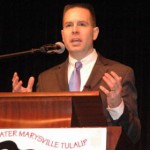Local seed companies offer advice to help you plan for a bountiful harvest

By Debra Smith, Special to The Herald, http://www.heraldnet.com
Now is the time to get out the seed catalogs and start planning for that bounty.
Representatives from two Pacific Northwest seed companies shared some tips for choosing what to grow, and some of the hot new items in their catalogs. Both companies offer catalogs packed with growing information.
Irish Eyes Garden Seeds, as the name hints, specializes in potatoes. The Ellensburg-based company also offers a variety of heirloom, organic and nongenetically modified vegetable and flower seeds.
Owner Greg Lutovsky suggested trying a potato called Yukon Gem. It’s a private variety bred by a group of growers his nursery belongs to. The potato is late blight resistant — the fungal disease that led to the Irish potato famine — which means it’s incredibly hard to kill.
The potato is also quite tasty, just like one of its parents, Yukon Gold, Lutovsky said.
“You’d find some right now if you went into my kitchen,” he said.
He also recommended a russet-type potato for baking called Defender, and a purple fingerling called Purple Peruvian.
Lutovsky also offered a general piece advice for gardeners in Western Washington. Pay close attention to the “days to maturity” information listed with seeds. Eighty days to maturity is about the maximum gardeners can get away with in this area, and that’s pushing it without starting plants inside a greenhouse or using other season-lengthening techniques.
Plants bred to grow compactly in containers continue to be a popular trend, said Tim Russell, the marketing manager for Territorial Seed Co., based in Cottage Grove, Ore.
“A lot of people want to get into gardening, but they don’t have a big yard,” he said.
This year, Territorial offers a new cucumber called Patio Snacker. The cuke was bred for containers, as it stays in a tight, semi-bush shape and can be trained to grow up a trellis.
Another new plant for containers and small spaces is a cherry tomato called Lizzano. The plant gets about 20 inches tall and wide, Russell said. He suggested it tucking into a basket in a sunny spot. At 65 days to maturity, it produces relatively quickly for a tomato, a necessity in the cool Northwest.
Territorial began offering a zucchini last year called Patio Star and it proved popular, Russell said. The squash plant stays compact and produces shapely, deep green fruit. Gardeners can maximize space by packing them tightly together or planting among other crops.
The company also is offering plants that have been grafted to different rootstocks to maximize production and improve resistance to disease. Two years ago, the company started offering tomatoes. Last year it was eggplants. This year, gardeners also can try grafted peppers.
Territorial also is now offering seed tape and disks: Seeds, such as radishes and carrots, are embedded into biodegradable paper. The advantage here is gardeners don’t need to thin plants as they grow, and the seeds are perfectly spaced.
The seeds come embedded on long strips of paper intended for row planting. There are also a variety of herbs planted onto paper disks, aimed at gardeners who want to quickly and easily plant a container.








